2010 Alfa Romeo Brera/Spider window
[x] Cancel search: windowPage 92 of 271

90
SAFETY
DEVICES
WARNING
LIGHTS AND
MESSAGES
IN AN
EMERGENCY
CAR
MAINTENANCE
TECHNICAL
SPECIFICATIONS
INDEX
DASHBOARD
AND
CONTROLS
CORRECT USE
OF THE CAR
BOOT
Boot unlocking is electric and it is dis-
abled when the car is running.
Using the “Setup Menu” (or the Ra-
dionavigation System on certain ver-
sions) boot opening can be set by se-
lecting the option “Indep. boot” (see
paragraph “Reconfigurable multifunction
display” in this section): the boot can
only be opened by pressing the elec-
tronic key button
`.
Improper boot closing is indicated by
symbol
Rand a message on the dis-
play (see section “Warning lights and
messages”).
A0F0271mfig. 71
When unlocked, the boot can be
opened from outside the vehicle press-
ing the electric logo (fig. 71) until it
snaps unlocked.
Tailgate raising is facilitated by the side
gas shock springs.
Opening the boot its internal light will
turn on and it will go off automatically
when re-closing the tailgate. Leaving the
tailgate inadvertently open, the light will
turn off automatically after a few min-
utes.
Improper use of the
power windows can be
dangerous. Before and
during its operation ensure that
any passengers are not at risk
from the moving glass either by
personal objects getting caught
in the mechanism or by being in-
jured by it directly. Always re-
move the ignition key when get-
ting out of the car to prevent the
power windows being operated
accidentally and constituting a
danger to the passengers in the
car.
Passenger’s door
The passenger's door is provided with the
button for opening/closing manual-
ly/automatically the passenger's win-
dow.
Page 117 of 271
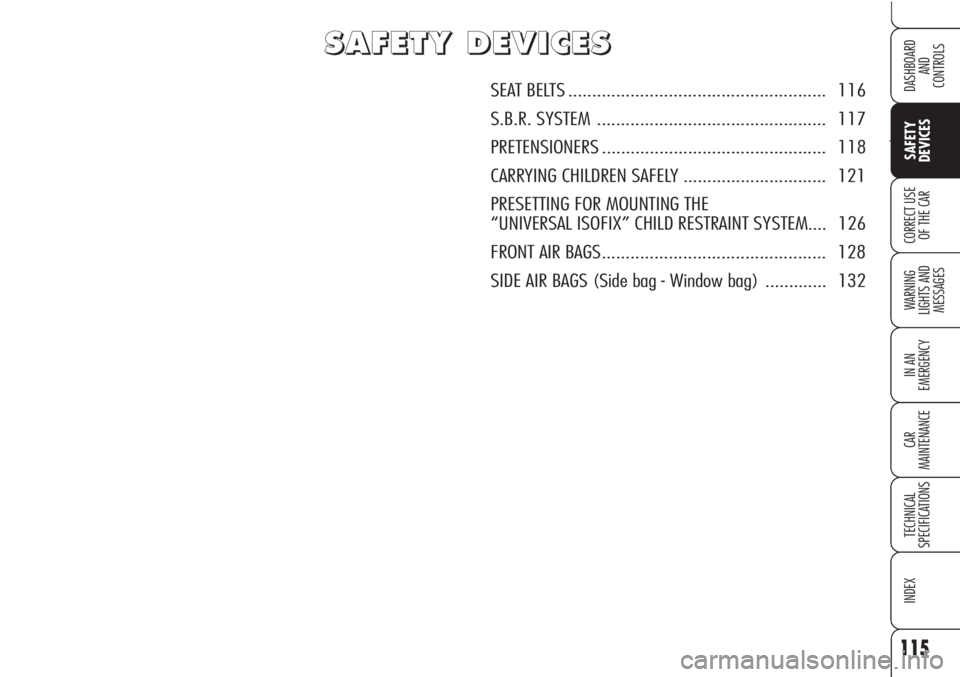
115
Ù
SAFETY
DEVICES
WARNING
LIGHTS AND
MESSAGES
IN AN
EMERGENCY
CAR
MAINTENANCE
TECHNICAL
SPECIFICATIONS
INDEX
DASHBOARD
AND
CONTROLS
CORRECT USE
OF THE CAR
S S
A A
F F
E E
T T
Y Y
D D
E E
V V
I I
C C
E E
S S
SEAT BELTS ...................................................... 116
S.B.R. SYSTEM ................................................ 117
PRETENSIONERS............................................... 118
CARRYING CHILDREN SAFELY .............................. 121
PRESETTING FOR MOUNTING THE
“UNIVERSAL ISOFIX” CHILD RESTRAINT SYSTEM.... 126
FRONT AIR BAGS............................................... 128
SIDE AIR BAGS (Side bag - Window bag) ............. 132
Page 134 of 271
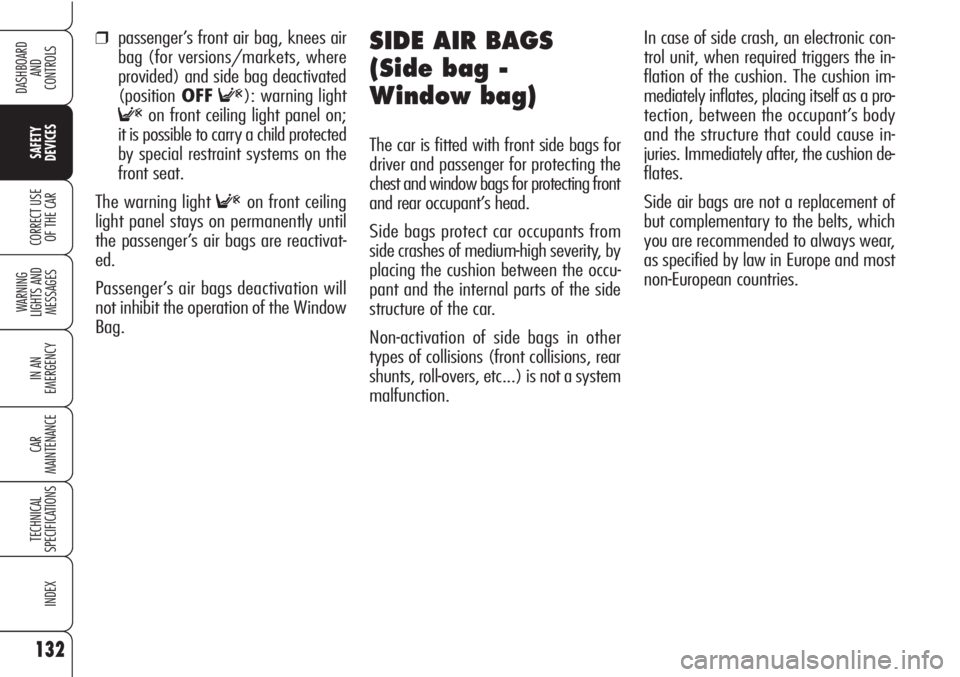
132
SAFETY
DEVICES
WARNING
LIGHTS AND
MESSAGES
IN AN
EMERGENCY
CAR
MAINTENANCE
TECHNICAL
SPECIFICATIONS
INDEX
DASHBOARD
AND
CONTROLS
CORRECT USE
OF THE CAR
❒passenger’s front air bag, knees air
bag (for versions/markets, where
provided) and side bag deactivated
(positionOFF
F): warning light
Fon front ceiling light panel on;
it is possible to carry a child protected
by special restraint systems on the
front seat.
The warning light
Fon front ceiling
light panel stays on permanently until
the passenger’s air bags are reactivat-
ed.
Passenger’s air bags deactivation will
not inhibit the operation of the Window
Bag.
SIDE AIR BAGS
(Side bag -
Window bag)
The car is fitted with front side bags for
driver and passenger for protecting the
chest and window bags for protecting front
and rear occupant’s head.
Side bags protect car occupants from
side crashes of medium-high severity, by
placing the cushion between the occu-
pant and the internal parts of the side
structure of the car.
Non-activation of side bags in other
types of collisions (front collisions, rear
shunts, roll-overs, etc...) is not a system
malfunction.In case of side crash, an electronic con-
trol unit, when required triggers the in-
flation of the cushion. The cushion im-
mediately inflates, placing itself as a pro-
tection, between the occupant’s body
and the structure that could cause in-
juries. Immediately after, the cushion de-
flates.
Side air bags are not a replacement of
but complementary to the belts, which
you are recommended to always wear,
as specified by law in Europe and most
non-European countries.
Page 135 of 271
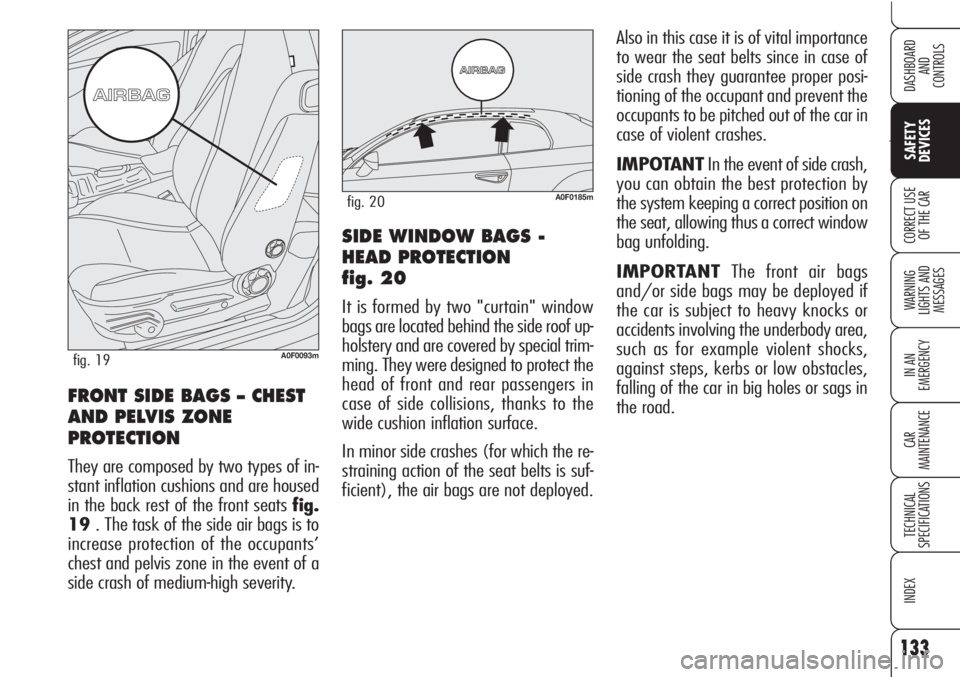
133
Ù
SAFETY
DEVICES
WARNING
LIGHTS AND
MESSAGES
IN AN
EMERGENCY
CAR
MAINTENANCE
TECHNICAL
SPECIFICATIONS
INDEX
DASHBOARD
AND
CONTROLS
CORRECT USE
OF THE CARSIDE WINDOW BAGS -
HEAD PROTECTION
fig. 20
It is formed by two "curtain" window
bags are located behind the side roof up-
holstery and are covered by special trim-
ming. They were designed to protect the
head of front and rear passengers in
case of side collisions, thanks to the
wide cushion inflation surface.
In minor side crashes (for which the re-
straining action of the seat belts is suf-
ficient), the air bags are not deployed.Also in this case it is of vital importance
to wear the seat belts since in case of
side crash they guarantee proper posi-
tioning of the occupant and prevent the
occupants to be pitched out of the car in
case of violent crashes.
IMPOTANTIn the event of side crash,
you can obtain the best protection by
the system keeping a correct position on
the seat, allowing thus a correct window
bag unfolding.
IMPORTANTThe front air bags
and/or side bags may be deployed if
the car is subject to heavy knocks or
accidents involving the underbody area,
such as for example violent shocks,
against steps, kerbs or low obstacles,
falling of the car in big holes or sags in
the road.
FRONT SIDE BAGS – CHEST
AND PELVIS ZONE
PROTECTION
They are composed by two types of in-
stant inflation cushions and are housed
in the back rest of the front seats fig.
19. The task of the side air bags is to
increase protection of the occupants’
chest and pelvis zone in the event of a
side crash of medium-high severity.
A0F0093mfig. 19
A0F0185mfig. 20
Page 136 of 271
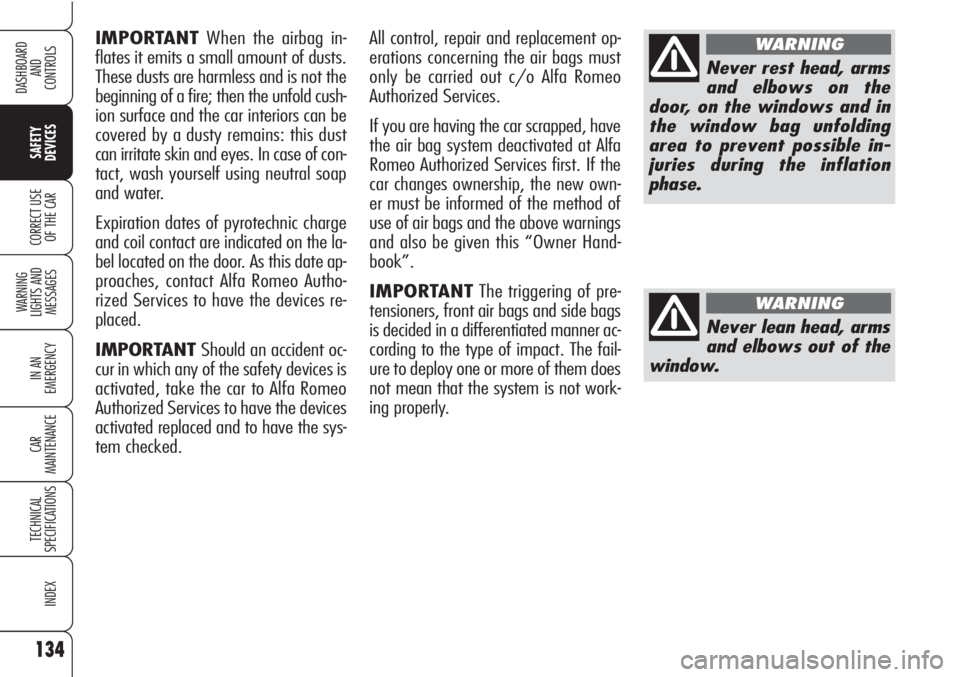
134
SAFETY
DEVICES
WARNING
LIGHTS AND
MESSAGES
IN AN
EMERGENCY
CAR
MAINTENANCE
TECHNICAL
SPECIFICATIONS
INDEX
DASHBOARD
AND
CONTROLS
CORRECT USE
OF THE CAR
IMPORTANTWhen the airbag in-
flates it emits a small amount of dusts.
These dusts are harmless and is not the
beginning of a fire; then the unfold cush-
ion surface and the car interiors can be
covered by a dusty remains: this dust
can irritate skin and eyes. In case of con-
tact, wash yourself using neutral soap
and water.
Expiration dates of pyrotechnic charge
and coil contact are indicated on the la-
bel located on the door. As this date ap-
proaches, contact Alfa Romeo Autho-
rized Services to have the devices re-
placed.
IMPORTANTShould an accident oc-
cur in which any of the safety devices is
activated, take the car to Alfa Romeo
Authorized Services to have the devices
activated replaced and to have the sys-
tem checked.All control, repair and replacement op-
erations concerning the air bags must
only be carried out c/o Alfa Romeo
Authorized Services.
If you are having the car scrapped, have
the air bag system deactivated at Alfa
Romeo Authorized Services first. If the
car changes ownership, the new own-
er must be informed of the method of
use of air bags and the above warnings
and also be given this “Owner Hand-
book”.
IMPORTANTThe triggering of pre-
tensioners, front air bags and side bags
is decided in a differentiated manner ac-
cording to the type of impact. The fail-
ure to deploy one or more of them does
not mean that the system is not work-
ing properly.
Never rest head, arms
and elbows on the
door, on the windows and in
the window bag unfolding
area to prevent possible in-
juries during the inflation
phase.
WARNING
Never lean head, arms
and elbows out of the
window.
WARNING
Page 147 of 271

145
SAFETY
DEVICES
WARNING
LIGHTS AND
MESSAGES
IN AN
EMERGENCY
CAR
MAINTENANCE
TECHNICAL
SPECIFICATIONS
INDEX
DASHBOARD
AND
CONTROLS
CORRECT USE
OF THE CAR
Climate control
The air conditioner is an additional load
which greatly affects the engine leading
to higher consumption. When the tem-
perature outside the car permits it, use
the air vents where possible.
Spoilers
The use of aerodynamic optional extras
which are not certified for the specific
use on the vehicle, may reduce the aero-
dynamic penetration of the vehicle and
increase consumption. Unnecessary loads
Do not travel with too much luggage
stowed in the boot. The weight of the
car (especially when driving in town)
and its trim greatly affects consumption
and stability.
Roof rack/ski rack
Remove the roof rack or the ski rack
from the roof as soon as they are no
longer used. These accessories lower air
penetration and adversely affect con-
sumption levels. When needing to car-
ry particularly voluminous objects, prefer-
ably use a trailer.
Electric devices
Use electric devices only for the amount
of time needed. Rear heated window,
additional headlights, windscreen wipers
and heater fan need a considerable
amount of energy therefore, increasing
the requirement of current increases fu-
el consumption (up to +25% in the ur-
ban cycle).CONTAINING
RUNNING COSTS
Here are some suggestions which may
help you to keep the running costs of
your car down and lower the amount of
toxic emissions released into the at-
mosphere.
GENERAL CONSIDERATIONS
Car maintenance
Have checks and adjustments carried out
in accordance with the “Service sched-
ule”.
Tyres
Check the pressure of the tyres routine-
ly at an interval of no more than 4
weeks: if the pressure is too low, con-
sumption levels increase as resistance
to rolling is higher.
Page 152 of 271
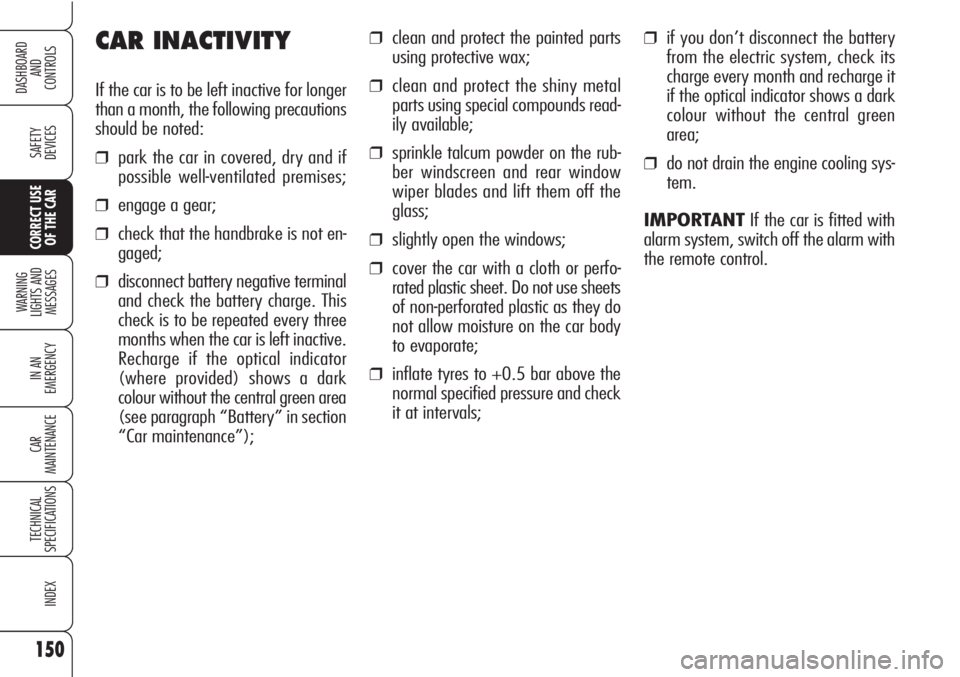
150
SAFETY
DEVICES
WARNING
LIGHTS AND
MESSAGES
IN AN
EMERGENCY
CAR
MAINTENANCE
TECHNICAL
SPECIFICATIONS
INDEX
DASHBOARD
AND
CONTROLS
CORRECT USE
OF THE CAR
CAR INACTIVITY
If the car is to be left inactive for longer
than a month, the following precautions
should be noted:
❒park the car in covered, dry and if
possible well-ventilated premises;
❒engage a gear;
❒check that the handbrake is not en-
gaged;
❒disconnect battery negative terminal
and check the battery charge. This
check is to be repeated every three
months when the car is left inactive.
Recharge if the optical indicator
(where provided) shows a dark
colour without the central green area
(see paragraph “Battery” in section
“Car maintenance”);
❒clean and protect the painted parts
using protective wax;
❒clean and protect the shiny metal
parts using special compounds read-
ily available;
❒sprinkle talcum powder on the rub-
ber windscreen and rear window
wiper blades and lift them off the
glass;
❒slightly open the windows;
❒cover the car with a cloth or perfo-
rated plastic sheet. Do not use sheets
of non-perforated plastic as they do
not allow moisture on the car body
to evaporate;
❒inflate tyres to +0.5 bar above the
normal specified pressure and check
it at intervals;
❒if you don’t disconnect the battery
from the electric system, check its
charge every month and recharge it
if the optical indicator shows a dark
colour without the central green
area;
❒do not drain the engine cooling sys-
tem.
IMPORTANTIf the car is fitted with
alarm system, switch off the alarm with
the remote control.
Page 169 of 271

167
SAFETY
DEVICES
WARNING
LIGHTS AND
MESSAGES
IN AN
EMERGENCY
CAR
MAINTENANCE
TECHNICAL
SPECIFICATIONS
INDEX
DASHBOARD
AND
CONTROLS
CORRECT USE
OF THE CAR
ANTIPINCH SYSTEM
FAILURE (amber)
The display will show message
+ symbol when failure is detected in the
antipinch system.
Before contacting Alfa Romeo Autho-
rized Services perform window initial-
ization procedure (see section “Power
Windows” in chapter “Dashboard and
controls”). If the issue persists, refer to
Alfa Romeo Authorized Services.
5
WINDSCREEN
WASHER FLUID
LOW LEVEL
(amber)
The display will show message + sym-
bol when the windscreen washer fluid
level falls down the preset min. level.
)
SPEED LIMIT
EXCEEDED
The display will show the ded-
icated message + symbol (red) and the
buzzer will sound when the car exceeds
the speed limit set through the “Setup
Menu” (e.g.: 120 km/h) (see para-
graph “Reconfigurable Multifunction Dis-
play” in section “Dashboard and con-
trols”).X
T.P.M.S. SYSTEM
FAILURE
(for versions/markets,
where provided)
On certain versions the display will show
a warning message + symbol (amber)
when a failure is detected in the T.P.M.S.
system (Tyre Pressure Monitoring Sys-
tem). Contact Alfa Romeo Authorized
Services as soon as possible.
Should one or more wheels without sen-
sor be fitted, the display will show a
warning message until initial conditions
are restored.n
CHECK TYRE
PRESSURE
(for versions/markets,
where provided)
On certain versions the display will show
a warning message + symbol (amber)
to indicate the flat tyre.
Should two or more tyre be flat, the dis-
play will show the indications corre-
sponding to each tyre in sequence.
Restore proper inflation pressure values
as soon as possible (see paragraph
“Cold inflation pressures” in section
“Technical Specifications”).n